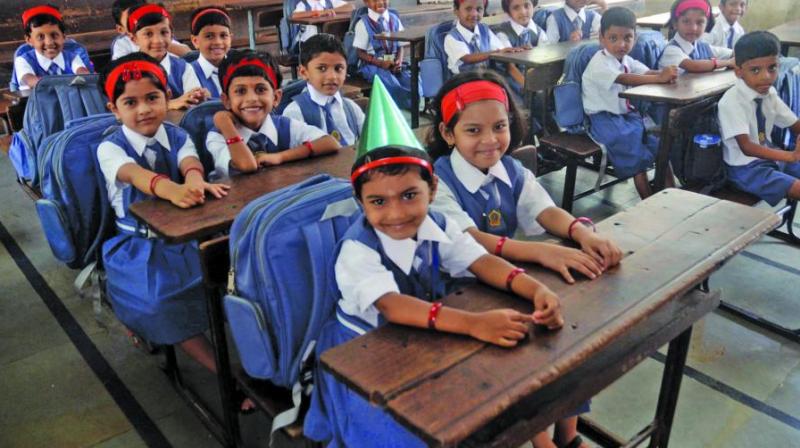Good news! Learning levels up in govt schools
The ASER data from 2014, 2016 and now 2018 suggest that these trends seem to be changing.

This year, the Annual Status of Education Report (ASER) team visited all rural districts in India and assessed children on foundational reading and mathematics after a gap of a year. And the slight signs we had seen of a resurgence in government school learning levels in 2016 seem to have taken root! Learning levels are up in most states in Class 3 and Class 5 - and this is good news indeed! Between 2005 and 2014 - the first 10 years of ASER - two main trends in learning emerged from the data.
First, at the all-India level, learning levels were low and slow to change till 2010. A slight decline is visible between 2010 and 2013, coming entirely from government schools, with learning levels in private schools holding up or improving slightly. Second, while children did learn as they progressed through school, these learning trajectories were fairly flat. Even in Class 8, close to a fourth of children were not fluent readers.
The ASER data from 2014, 2016 and now 2018 suggest that these trends seem to be changing. In 2014, learning levels seemed to stabilise. In ASER 2016, for the first time since 2010, there was an improvement in the government school learning levels, even though it was only observed in Class 3. This year, not only do we continue to see an improvement in government schools in Class 3 but also in Class 5. In Class 3, the percentage of children who can read a Class 2 level text fell from 17.4 per cent in 2009 to 15.9 per cent in 2013.
Subsequently, this proportion increased to 17.2 per cent in 2014, 19.3 per cent in 2016 and now stands at 20.9 per cent in 2018. In Class 5, on the other hand, the percentage of children who could read a Class 2 level text fell steadily from 50.7 per cent in 2010 to 41.7 per
cent in 2014. But finally, this figure shows an improvement in 2018 at 44.2 per cent.
Two points should be noted here. First, while at the all-India level these changes may seem small, they are not insignificant; and there is a lot of variation across states, with some states showing gains of close to 10 percentage points in 2018. Second, even though the declining trend in learning outcomes of government schools seems to have been arrested and even reversed, it is important to remember that we are talking about foundational abilities. There is still a long way to go to bring children to up to grade level.
With 70 per cent of rural children still attending government schools, and the government’s continued commitment to the Right of Children to Free and Compulsory Education (RTE), the distribution of learning outcomes in government schools becomes extremely important. The RTE was envisaged as a tool to guarantee access to education to all children in the country, thereby levelling the playing field and removing disadvantages associated with poverty, caste and gender.
To a large extent it has been successful in achieving that goal. Even though enrollment in the 6-14 year age group was already over 96 per cent in 2010 when the RTE came into effect, there were still large numbers of children out of school in the 11-14 year age group, especially among girls. Today the proportion of girls aged 11-14 who are out of school has decreased to four per cent, and there are only four states where it is more than five per cent. Therefore, the RTE, as an overarching legislation, also reduced the inequalities in access between states.
How has this push towards universalisation affected the distribution of learning outcomes in government schools? The fact that learning levels fell after the RTE came into effect in 2010 is well documented now. This observed decline could be due to a variety of reasons, but one possible explanation could be that it is a direct consequence of bringing children who had never enrolled or had dropped out back into school. These children, understandably, would have lower learning levels and need supplementary help to be at par with their peers. If teachers are unable to provide this extra help, the result would lower average learning levels in government schools. Over time, as these children catch up, we would expect learning levels to start rising.But is this what has happened? This year we see an increase in learning in Classes 3 and 5, but did all children benefit?
There is a lot of variation across states not just in the level of learning outcomes but also how they have changed over time. For instance, when the overall proportion of Class 3 children who could read at grade level fell from 16.8 per cent in 2010 to 14.7 per cent in 2011, there were states like Punjab and Gujarat that posted increases of close to six percentage points; at the other end of the spectrum, in Haryana and Rajasthan, this proportion fell by five percentage points and in Bihar by nine percentage points. This large variation across states is evident not just in the “bad times” but also in the “good times”. This year, when most states have shown an improvement, in Rajasthan the percentage of Class 3 readers fell by five percentage points; and in Tamil Nadu the drop was even greater, at over eight percentage points.
It is not surprising, therefore, that there was no sustained trend in learning outcomes between 2010 and 2014.
Even after 2014, when the overall learning levels have shown a slight upward trend, very few states show sustained improvements. For instance, Rajasthan had a big jump of five percentage points in 2016, but an equally large fall in 2018, bringing it back to the 2014 level. Telangana is another case in point - with a three percentage point increase in 2016 and a similar fall in 2018. Just a handful of states have shown a sustained and significant increase in learning outcomes after 2014. Only four states have showed an improvement of three percentage points or more in both 2016 and 2018 - Punjab, Haryana, Gujarat and Maharashtra.
In the past few years, the focus has clearly shifted from enrollment to learning in education. Governments - both state as well as Central - have instituted their own learning assessments. In 2017, an amendment to the RTE required all states, except Jammu and Kashmir, to prepare “class-wise, subject-wise learning outcomes for all elementary classes”, and also to devise “guidelines for putting into practice continuous and comprehensive evaluation, to achieve the defined learning outcomes”.
Just recently, the second amendment to the RTE Act did away with the no-detention policy in Class 5 and Class 8, giving states the flexibility to detain students if they do not pass the relevant examinations. But, as states embark on achieving the goals of RTE 2.0, they must ensure that all children participate and gain from the process.

